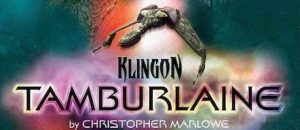Mil Grus does double duty as the name of “Los Angeles’s Premier Bouffon Troupe” and their eponymous show at the 2019 Hollywood Fringe Festival. Ostensibly based on Pliny the Elder’s story of a Thousand Cranes, a five member ensemble in heavy padding, tights, and grotesque makeup do various skits and improvisational bits taken from (if not exactly inspired by) extensive crowd work and audience participation. The closest hooks to cranes are the elegant little origami handed to a few of us in the front row (right) with the totality of the hour being a mystery. The young and young-at-heart in the packed McCadden Place Theatre roared and ohmyGODded with every twitch, tic, and bit of shtick. Being neither, I was tossed into my recurring nightmare of the final exam in a class I never knew I was taking. If there were references I didn’t get them and if there was a through line, it escaped me. The performers do show talent in physical theatre and this may have been an intentionally loosely-formatted bit of nonsense for a festival audience. Perhaps their other offerings have at least some structure for those of us that need it.

The swan-like Bird of Prey from the Klingon Tamburlaine Photo courtesy School of Night Theatre Company
Summertime is usually Shakespeare season but one festival company has taken on on the daunting task of mounting rival Marlowe. This is no easy task as there are probably very good reasons why Shakespeare (or Bacon or DeVere or whomever) has dropkicked contemporaries to the curb over the past few hundred years. Let’s blindly extrapolate from one or two encounters with the rest and assert that their language isn’t as smooth, their characters as fleshed, or their plots as nuanced. Nevertheless, School of Night Theatre‘s adaptation of “Tamburlaine the Great Parts 1 and 2” into the Star Trek milieu is galactic in scope, brazen in ambition, and a stone cold marvel. Historical Timur/Tamerlane/Tamburlaine was such a brutal and unrepentant conqueror that transplanting him into a Klingon makes eminent sense. It is easier to recognize savagery in the other than to acknowledge it in the self. The uncredited adapter also cleverly remaps various tribes and city-states involved in an endless series of wars into Vulcan, Romulan, and Starfleet counterparts. Played straight, Tamburlaine’s unremitting and unpunished transition from shepherd to despot would wear thin quickly but Director Christopher Johnson deftly leavens the grim proceedings with wry humor, sight gags, posturing, and plenty of tongue.
This production would be a tight fit in an outdoor venue and it is the height of q’hutzpagh to put a fully costumed beak-over-tailfeathers cast of 13 and a percussionist/Foley artist into the 360 square feet offered by the Complex Theatres. The action is non-stop, full-tilt, loud, and a tad too long with commedia head snaps and full throated oration from start to finish. Neither is this a land-bound adaptation. The large design team puts together epic space battles with supernumeraries, starship models, and clever lighting although the bulk of the fighting is incongruously hand-to-hand combat with pointy objects and blades.
There is no comeuppance, no divine retribution, and no great moral to the story other than lying, cheating, nepotistic, usurping sleazeballs can and do get away with it. Some things don’t change over the centuries. If there is a criticism of the production it is that it might have reached out to LA’s vibrant Klingon community to cast parts currently played by human actors in prostheses and makeup. The theatre world has taken steps toward inclusivity but there is always room to grow.
Mil Grus by Mil Grus Theatre
Closed at the Hollywood Fringe Festival 2019
McCadden Place Theatre
Klingon Tamburlaine by School of Night Theatre
Remaining performances: Thursday 27 June at 8:30pm and Saturday 29 June at 4pm
Ruby Theatre at The Complex, Hollywood
6476 Santa Monica Blvd
Los Angeles, CA
Online tickets via the Hollywood Fringe Festival
Youtube Channel: The Vestibules
Youtube Channel: KyleKallgrenBHH



